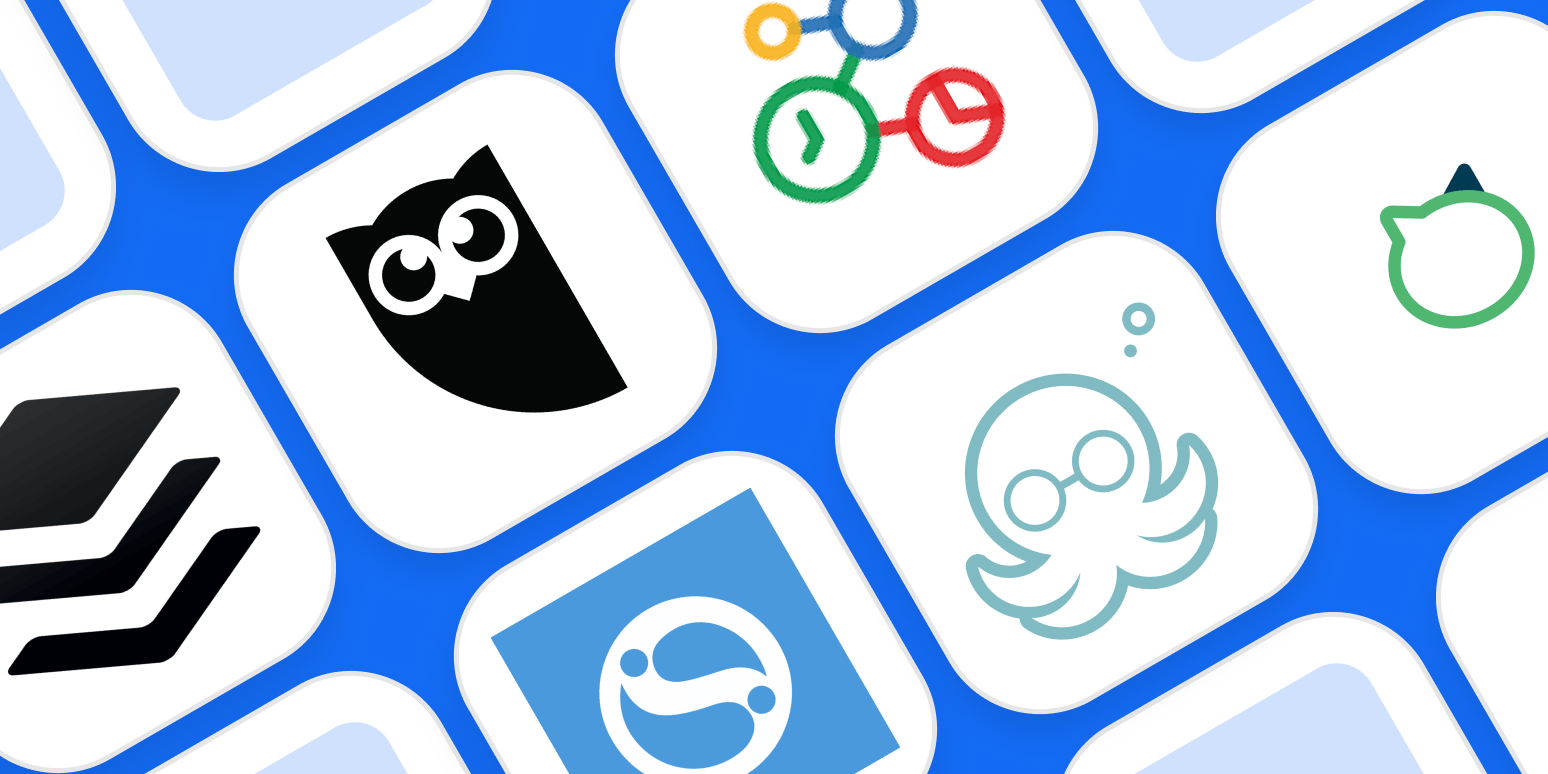Social media is a powerful tool for small businesses. You can use it to find new customers, drive traffic to your website, and keep in touch with existing clients. But managing all the different social networks using their consumer apps is, at best, time-consuming and slow, and, at worst, next to impossible. If you really want to run your social media properly, you need the right tools.
Use automation to share, engage, and cross-post without lifting a finger
Social media management tools enable you to automate, analyze, better control, and dive deeper into your social media accounts, so you can focus on creating great content. These apps can post the same updates on all your social accounts, schedule future updates, and help you find the most appropriate and effective content to post and times to post it.
We put nearly 50 of the best social media management software solutions through their paces, and here are our picks for the nine best for small businesses.
The best social media management tools
-
Buffer Publish for straightforward social media scheduling
-
Hootsuite for all-in-one social media scheduling, monitoring, and analytics
-
Zoho for team-based social media management
-
MeetEdgar for automating your social media posts
-
Loomly for generating post ideas for social media
-
Sendible for lead generation on social media
-
Iconosquare for managing Instagram business accounts
-
Tailwind for managing Pinterest accounts
-
Later for cheap (or free) visual social media marketing
What makes a great social media management tool?
With so many social media apps to choose from, many of them with specific, niche features, we set out some pretty firm criteria on what makes a great social media management tool.
-
Each app had to either support a wide range of different social networks, so you could control your complete online presence in one place, or it had to be a particularly powerful solution for a single social network. Because of the differences among all the social networks, it’s mostly an either-or situation. The apps that make it easy to post on Facebook, Twitter, and Reddit simultaneously don’t offer the deep analytics that a Twitter-focused app does. The different social sites just don’t give developers the same tools across the board. If you’re not sure which social media apps to use in the first place, here are some tips on how to choose the best social media platform for your business.
-
Social media is a time-suck for individuals—and it’s the same for small businesses. Running your social media accounts shouldn’t be a hands-on job. Scheduling future posts and updates, so you can batch all your social media work into one or two blocks a week, is absolutely essential. And it’s one of the key features all these apps have.
-
There’s no point just posting randomly into the void. For good social media marketing, you need to be able to assess how your different updates perform in general, and compared to each other. Every app on this list offers some performance analytics on the updates you post with it, so you can see what works and what doesn’t. Some go further and let you analyze your followers and other details from your social media accounts.
-
Some apps offer social media monitoring and “listening” features so you can automatically analyze what people are saying about your business, keep track of your competitors, and otherwise turn the firehose into meaningful information. These features are more costly for services to offer, so they weren’t required for inclusion for the more affordable apps; for more expensive apps, however, they were a must.
-
Finally, all the apps had to be cost-effective for small businesses. There’s no point paying for a load of enterprise- or influencer-focused features that don’t help you run your social media better. Price didn’t matter for inclusion, so much as value for money.
It’s also worth noting that every app has a free trial or even a totally free plan. Don’t decide on one based just on our observations; try the two or three that sound like they will suit you best, and go from there.
Best social media management tool for straightforward social media scheduling
Buffer Publish (Web, iOS, Android, Chrome, Firefox, Safari)
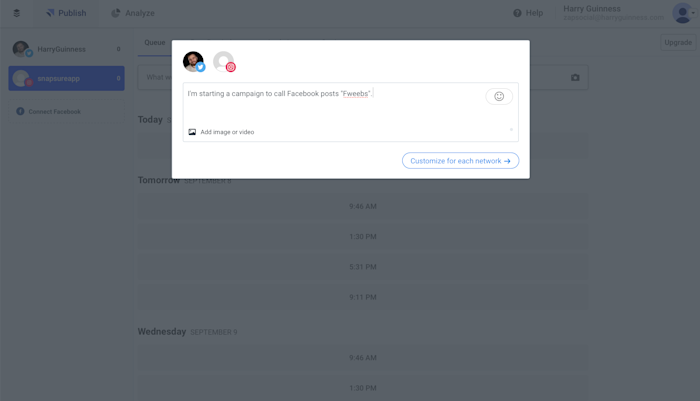
Buffer (though the service is now officially called Buffer Publish) is one of the longest-running social media tools aimed primarily at scheduling posts. It supports Facebook, Twitter, LinkedIn, and Instagram, and Pro users can schedule Pinterest updates too. Free users can connect up to three social accounts, including Facebook Pages and groups.
When you first connect a social account, Buffer will create a schedule for you. By default, Buffer creates four slots per day: in the morning, around noon, late-afternoon, and later in the evening for the time zone you’ve selected. Head to Settings > Posting Schedule to tweak this at any time, delete or add time slots, or disable an entire day. The more slots you have, the more updates you will need to schedule, but scheduling updates is easy with Buffer’s intuitive dashboard, mobile apps, and browser extensions.
For scheduling content from the web, Buffer offers browser extensions for Chrome, Firefox, Opera, and Safari. Click the Buffer icon in your toolbar (or use a keyboard shortcut), compose your update, and click Add to Queue to schedule. There are also mobile apps available for both iOS and Android, so you can schedule on the go. We tested the iOS app and found it easy to add updates using the Buffer Extension, which lets you “share” content directly to Buffer from virtually any other app. Your queue, sent posts, and posting schedule are all accessible from the app, and composing an update is a matter of tapping the big plus button at the bottom of the screen.
Buffer Publish includes limited insights into post performance (and none for free users). You can see the number of impressions your post achieved, the number of clicks on any links you included, comments, shares, and overall reach. Since Buffer Publish is primarily aimed at scheduling updates, this is a small part of the package. Buffer also offers Buffer Analyze, which has significantly deeper analytics into things like engagement metrics, follower demographics, and organic vs. paid posts, but it costs an additional $35/month.
Buffer can be collaborative—but only if you’re willing to cough up for a more expensive plan that removes the need to hand out credentials and allows you to approve new posts before they’re added to the queue.
With Zapier, it’s easy to link any other service you use to Buffer. For example, you can automatically add new blog posts to your schedule, either directly from WordPress or through an RSS feed.
Buffer Price: Free plan includes one user, three accounts, and 10 queued posts per profile; from $15/month for the Pro plan that includes one user, eight accounts, and 100 queued posts per profile.
Best social media management tool for all-in-one scheduling, monitoring, and analytics
Hootsuite (Web, iOS, Android, Chrome)
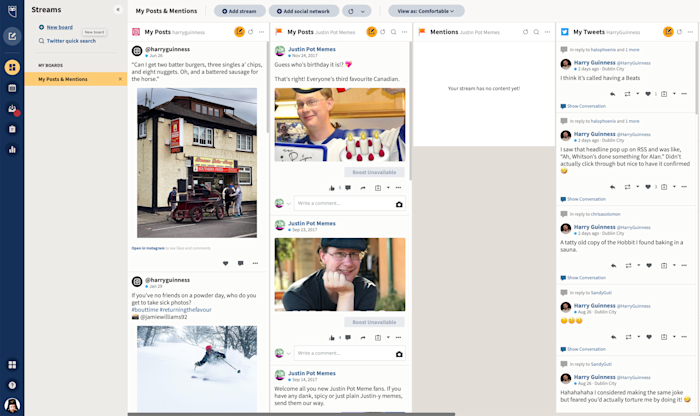
If you’re looking for a complete solution to all of your social media management needs, Hootsuite will cover all your bases. The app is compatible with over 35 social networks, including Facebook, Twitter, YouTube, Instagram, and Pinterest. More network connections are available through the Hootsuite app directory, a user-maintained database of extensions (which can be hit or miss).
Hootsuite includes a full scheduler for queuing posts at times of your choosing. You can create your own schedule or use the AutoSchedule function to schedule your updates at optimal engagement times. By uploading a CSV file with pre-prepared updates, you can fill your queue for days, weeks, months, or the duration of an entire social campaign. Once you’ve filled up your queue, it’s easy to view your outgoing posts from the Planner and reorder your update schedule with a simple drag and drop.
One of Hootsuite’s strongest areas is analytics, though you need one of the more expensive plans to get the full suite of them. The tool helps you understand social results by drawing on more than 200 metrics to measure performance. Once you’ve generated reports, you can export them as Excel, PowerPoint, PDF, and CSV files for use within your organization. You can run similar reports to measure team or individual performance.
Hootsuite can also help you monitor the social web with custom social streams. These customizable feeds let you watch the social web for mentions, new followers, search terms, hashtags, engagement, and more. You can construct precise streams that include or exclude specific keywords, post types, locations, and languages. As an example, if you’re in the business of selling custom portraits, you could target the search term portrait :( filter:images to find negative posts that mention the word “portrait” with an attached image. You could then target these users with your own business.
Assign access to various team members to avoid handing out passwords, with custom permission levels on a per-user basis. Your team members can use Hootsuite’s included Content Library to compose updates with on-brand assets of your choosing. Hootsuite includes free stock photos and GIFs courtesy of GIPHY, or you can connect Dropbox, Google Drive, and OneDrive to draw on your own resources, or your paid account with services like Adobe Stock. You can even assign tasks to your team members (like responding to comments or incoming messages), then approve the outgoing responses before they’re sent.
The Hootlet extension for Chrome lets you schedule updates while browsing the web, and it works with the aforementioned AutoSchedule feature too. Mobile apps for iOS and Android let you schedule, edit, approve, and manage updates from anywhere. It’s a complete package, but you’ll need to dig deep to unlock the full bounty of features.
Hootsuite also integrates with Zapier, so you can do things like automatically thank new Twitter followers or create new messages with your task management app.
Hootsuite Price: Free plan includes one user, three social profiles, and 30 scheduled updates; from $39/month (billed annually) for the Professional plan that includes one user, 10 social profiles, and unlimited scheduling; team plans start at $129/month (billed annually).
Best social media management tool for team-based social media management
Zoho Social (Web, iOS, Android)
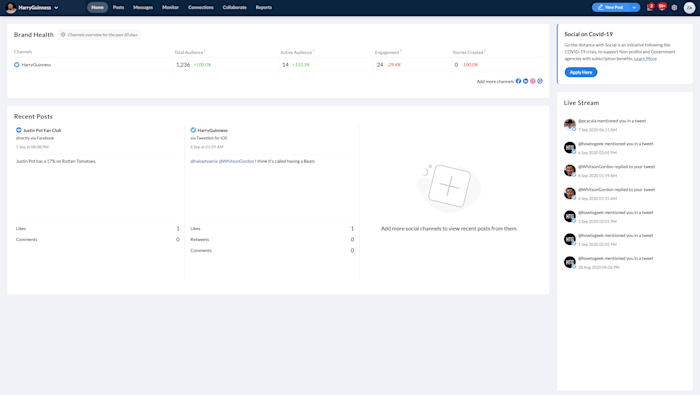
Zoho Social is a complete social media management tool for Twitter, Facebook, Instagram, LinkedIn, and Google My Business. It has all the scheduling tools you need; you can let Zoho Social automatically queue updates, line them up yourself, and have it post to all your social networks at once.
Where Zoho Social really sets itself apart is with its team features. Unlike most apps at this price point, Zoho Social’s $15/month Standard plan includes two team members—and you can add more for an extra $10/month per user. This means you can let your employees manage your social media without handing out your all-important password.
You can limit team members to specific social networks when you invite them, or assign them different roles if, say, you only want managers to be able to publish posts while you want everyone to be able to reply to comments and messages. To set up a new role, go to Settings > Roles & Permissions and click Create New Role. Then you can assign whether anyone with it has permission to publish posts, respond to messages, comment and reply, or view advanced reports.
There’s even a dedicated Collaborate tab and a built-in messenger system so you don’t need to deal with your social media ideas over email or in Slack. You can plan, manage, and discuss everything with your team in Zoho Social.
When it comes to social monitoring, Zoho Social again sets itself apart from many other social media services in its price bracket. On your home page, you can see a Live Stream of how people are interacting with you online. If someone tweets at you, comments on a post, or sends you a DM, you’ll see it instantly. You can also use the Monitor tab to set up a customized dashboard to keep track of the interactions that matter most to you—or even your competitors. For example, you can set up a column that searches Twitter for negative reviews about competing products, so you can reach out to some unhappy customers of your competitors.
Zoho Social Price: From $15/month for the Standard plan, which includes seven channels and two team members.
Best social media management tool for automating your posts
MeetEdgar (Web, iOS, Chrome)

MeetEdgar is like an autopilot for your social media accounts. It does a lot of the heavy lifting for you and is compatible with Facebook, Twitter, LinkedIn, and Instagram. This isn’t an analytics tool—just a scheduling one. It includes the usual post scheduling features you’d expect to see in such a package, including the bulk importing of a series of cross-network updates.
What makes MeetEdgar so different is its automation. The app can find quote-worthy text from links, and then compose updates to go along with them. Simply click on Add New Content in the top-right corner of your dashboard, select an account and category, then paste your link into the text box. When you click Auto-Generate Variations, MeetEdgar will create four possible updates based on the contents of your link. You can edit them, delete them, or add your own manual variations, and then click Save to Library. This is the only tool we came across while researching that actually creates your content for you. Better still, it can generate variations on past updates that have performed well, making it easy to recycle updates without duplicating content.
Another standout feature is the ability to categorize your updates. Add different types of content to different categories, so you can better space out content types over the course of your schedule. You may want to create one category for blog posts, another for how-to posts, and another for promotional material. Color-coded categories make it easy to ensure your schedule contains a good range of content that will appeal to different users.
There’s little in the way of analytics tools in MeetEdgar, but the app does implement A/B testing to isolate best practices; plus, you can use the built-in ed.gr link shortener to track clicks. You can schedule content via the web, via the Chrome extension, or using a bookmarklet for Safari and Firefox.
MeetEdgar integrates with Zapier so you can, for example, automatically add your and other folks’ articles to your Edgar library for posting.
MeetEdgar Price: $19/month for Edgar Lite with three social media accounts, unlimited media library, four categories, and unlimited support.
Best social media management tool for coming up with post ideas
Loomly (Web, iOS, Android)
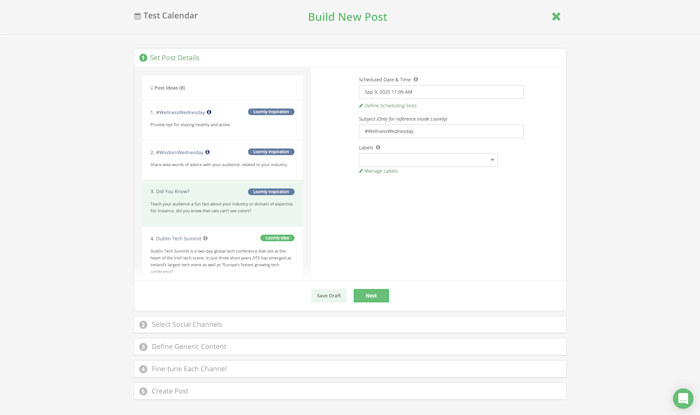
If you have the kind of company that likes to be kept abreast of International Mac and Cheese Day or reminded that the US Open is on so you can run promotional tie-ins, Loomly is the app for you. It suggests hashtags, trends, and events so you’ll never be short on post ideas or topics to weigh in on.
On your dashboard and when you create a new post, Loomly presents you with a number of post ideas. They can be related to your industry (which you select when you set up a calendar for the first time), things trending on Twitter, current events that Loomly’s team thinks are newsworthy, or just random ideas. For example, I’m writing this on a Wednesday, so Loomly suggested both #WellnessWednesday and #WisdomWednesday as potential ideas.
If you want to look into the future and plan your social media in advance, go to your calendar and click into the Ideas view (it’s the little lightbulb icon). Loomly will then present you with a calendar of upcoming events, holidays (big and small), and other things for post ideas. You can even add your own. Just hover over any day, and click Add Post Idea. Give it a title, description, and, if you want, make it recur every week, month, or year. This way, you can make sure you never forget your company’s anniversary, or you can add your own weekly event, like #ZapierZaturday.
Outside of generating post ideas, Loomly is a complete scheduling tool for Facebook, Instagram, Twitter, Pinterest, LinkedIn, Google My Business, and more. It’s got built-in analytics as well as collaboration and team features, so you can let everyone come up with post ideas while still holding final approval. You can also, of course, respond to tags, messages, and comments directly from the app.
If you’re looking for continuous inspiration with your all-in-one social media app, Loomly’s a great fit. It even integrates with Zapier, so you can do things like automatically create post ideas from Google Calendar events or create draft posts when you add new products to your Shopify store.
Loomly Price: From $34/month for the Base plan with one user, 10 social accounts, and core features.
Best social media management tool for lead generation
Sendible (Web, iOS, Android, Chrome)
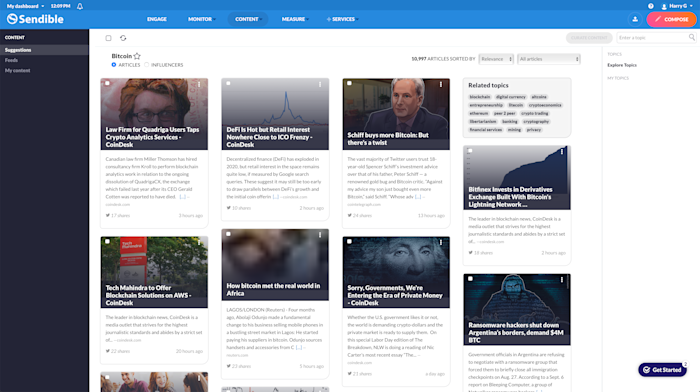
Sendible is another complete social media management package, with a few features that make it stand out from the crowd. It’s compatible with about 10 social networks and blog services, including Facebook, Twitter, LinkedIn, YouTube, Pinterest, and WordPress. Sendible can also connect to Google My Business, Tumblr, Facebook Pages, Blogger, and others.
As you’ve likely come to expect, a full set of scheduling tools is included. You can queue up posts for all connected social networks, blogs, and mailing lists. Smart Queues make it easy to maximize engagement by adjusting publication times for you, with the option of setting your best-performing evergreen content to be automatically recycled in the future.
These scheduling tools are among some of the best in the business. A shared calendar displays all of your pending updates across any networks you have connected, with the option of connecting RSS feeds to curate and automatically schedule future content. While composing your updates, you can use Flickr and Google Image search to find suitable royalty-free images, or design your own images using Sendible’s Canva integration.
Generating leads with Sendible is a matter of setting up an appropriate keyword alert under Monitor > Keywords > New Monitor. This tool lets you pick which keywords you want to target, optional inclusions and words you want to exclude, and where the posts were made. You can then browse the list of relevant keyword results from your dashboard or have them automatically emailed to you on a daily or weekly basis. You can even choose to just receive the positive or negative alerts.
No service would be complete without a full set of analytics tools, including a Google Analytics integration to help measure the effect that social campaigns have on website traffic. The app comes with some ready-to-run reports, or you can craft your own if you’re on the Traction plan or higher. Then you can set them to run at regular intervals, and have the results emailed to yourself, your team, or clients.
Finally, there’s a full suite of collaboration tools, including a shared media library, the ability to delegate tasks to teams or individuals, and per-user or per-team permissions.
Sendible Price: From $29/month for the Starter plan that includes one user, 12 services, and unlimited scheduling.
Best social media management tool for managing Instagram business accounts
Iconosquare (Web, iOS, Android, Chrome)
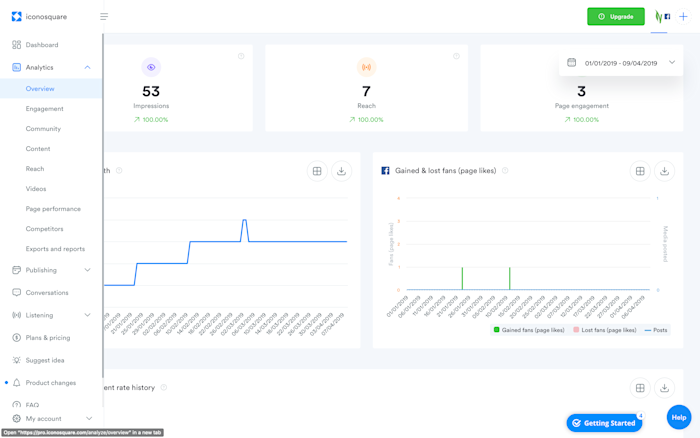
Few services offer such deep management of Instagram accounts as Iconosquare. Aimed almost entirely at those with Instagram business accounts and Facebook Pages (although it can also connect to Twitter), Iconosquare helps you monitor, publish, and analyze visual content on the social web. The service uses a modern, responsive dashboard that feels like it has been designed with the Instagram generation in mind. Navigation is simple using the pop-out menu to the left of the screen, with clean white backgrounds, bold typography, and sparing use of eye-catching colors.
Iconosquare is able to schedule content in advance for both Instagram and Facebook. This includes single image and video posts for Facebook, plus Instagram carousels and Story updates too. Once you’ve filled up your queue, you can preview what your Instagram feed will look like using the Feed Preview feature. This is particularly handy for social media professionals who want to ensure the feed remains on-brand or adheres to a particular aesthetic.
The included Media Library can pull images from Dropbox and OneDrive to create a repository of content that’s ready to schedule. Navigate to Publishing > Media Library to choose between Dropbox and OneDrive, then select the images that you want to import. You can add labels and sort your library by source, so it’s easy to isolate images that came from your own cloud accounts. Anything you’ve used in a past update will be tagged as such, so you don’t make the mistake of creating duplicate posts.
While Facebook and Twitter integrations are present, it’s the Instagram features that set Iconosquare apart from other less-specialized tools. The app provides insights into your Instagram account that few other tools can match. Head to Analytics > Community to see follower count plotted on a chart that updates every hour. Or click Analytics > Reach to understand how many people your updates are reaching, when these people are online, and which posts work best. Track competitors (provided they have Instagram business accounts) to unearth their strategy and compare your own post times, hashtag use, and post popularity. And the Conversations area tracks each and every unread comment you have received over the last six months, in one place.
Under Listening > Feeds, you can construct your own custom social feeds to monitor up to 50 Instagram users or Facebook Pages in a single feed. This allows you to create topics that you can monitor to stay abreast of trends or rivals. You may want to create a “Rivals” feed and add your competitors’ social media accounts, then check it periodically to ensure your own content is just as engaging.
The Analytics area of Iconosquare’s dashboard is full of ready-to-go graphs that show you the most important statistics and trends pertaining to your social accounts. You can easily change the date range for displayed data in the top-right corner. There are several different pages of these graphs to browse, including Engagement, Reach, and Community. Download any of these in CSV or PNG format by hovering over the download button and making a selection. Some of the more useful charts include “Most engaging media” on the Engagement tab, “Age and Gender of your audience” under Community, and detailed story statistics under Stories.
Iconosquare Price: From $39/month for the Pro plan that includes two team members, three social profiles, and limited features; from $79/month for three team members, five social profiles, and a full set of features.
Best social media management tool for managing Pinterest accounts
Tailwind (Web, iOS, Android, Chrome, Firefox, Safari)
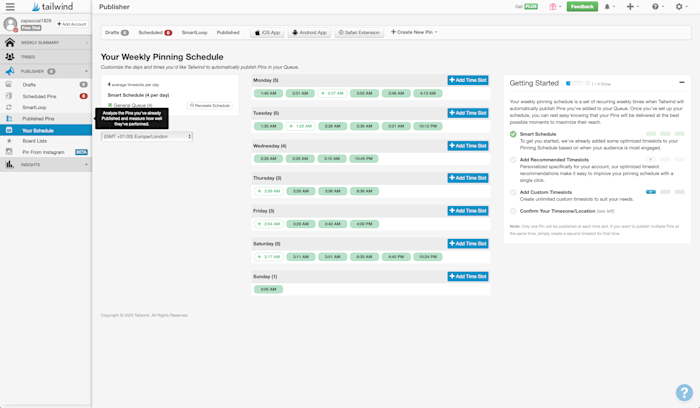
Pinterest is a special kind of social network. While Facebook is primarily used for interacting with others, and Twitter is a great way to follow news and trends, Pinterest is a far more introverted network. People who use Pinterest are focusing largely on themselves, discovering visual content they like and categorizing this content into easily retrievable collections.
Tailwind excels at Pinterest management like no other social media tool, and it also works with Instagram to provide total management of a brand on the visual side of the social web.
Tailwind provides a full set of tools for scheduling posts and monitoring the performance of your brand on Pinterest and Instagram. You can bulk upload by dragging and dropping images from your desktop. Click on the SmartLoop tab in your dashboard to set up a collection of Pins that will be automatically rescheduled, either continuously or between set dates if, for example, you want to share Christmas or Halloween ideas.
Just like other social media management software, Tailwind includes a smart scheduler to help decide when to best post your updates and maximize engagement. You can regenerate your schedule for maximum engagement at any time under Publisher > Your Schedule > Recreate Schedule—tell Tailwind how many times per day you want to publish, and it will take care of the rest. Clone Pins across as many boards as you like, or save groups of boards as a list and pin to all of them at once. Tailwind will even suggest trending content to you, with recommendations from relevant sources (alternatively, you can import your own RSS feeds to schedule Pins from sources of your choosing).
Tailwind includes a set of monitoring tools designed specifically for Pinterest. This includes pixel-matching technology and image recognition to see which images are most popular. Analytics reports let you measure your followers, engagement trends, and Pin virality. Performance indicators like repins and likes can be isolated to gauge how successful campaigns or content types are. While perusing Pin performance, it’s easy to re-use that content by clicking Add to SmartLoop or Re-Schedule this Pin.
An iOS app and Android app lets you draft and edit posts, queue content, and reorder your schedule on the move. Better still, browser extensions for Chrome, Firefox, and Safari let you schedule Pins (or multiple Pins) at once while browsing the web.
Tailwind Price: From $14.99/month for the Plus plan that includes one account, 400 posts per month, smart scheduling, analytics, and a 30-day history.
Best social media management tool for cheap (or free) visual marketing
Later (Web, iOS, Android)
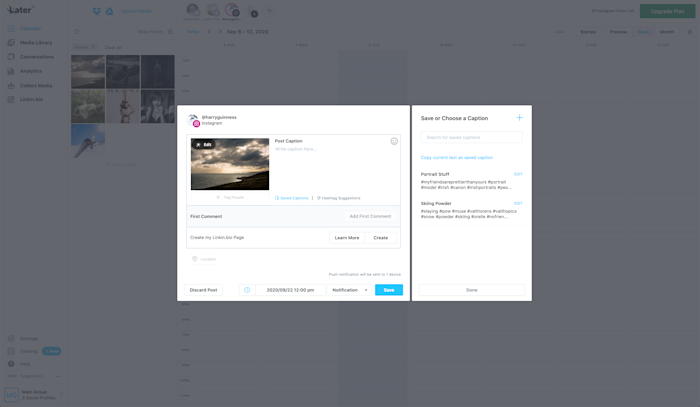
Later is a scheduling app for Instagram, Facebook, Twitter, and Pinterest, with one small catch: it’s only for posting images and other visual content. What sets it apart from many of the other social media scheduling apps is that Later has a free forever plan that’s robust enough for a lot of small businesses.
Later counts one Instagram account, Facebook Page, Twitter account, and Pinterest account as a “social set.” On the free plan, you get one social set with 30 scheduled posts per social profile, and a single user.
While Later can post images to Twitter, Facebook, and Pinterest, it’s with Instagram that it really stands out. On paid plans, as long as you have an Instagram for Business account, you can collect media and add it to your Library from stock photos; through Instagram by pulling content from specific hashtags, mentions, or tags; or by allowing invited contributors to upload their own photos. Just click on the Collect Media tab to dive down into the options.
Paid plans have even more options on what they can post: in addition to images, you can share videos, stories, and multiple photos in one post.
Later isn’t the fastest app, but its posting calendar looks great, and it’s simple to use. Just upload some photos to your Media Library (or use any of the other options for collecting them), and then drag and drop them to the time you want to post. If you’re bulk posting, I’d suggest doing this in Month view. Enter a caption or click Saved Captions to pull in something you’ve written before. On paid plans, you can use Hashtag Suggestions to automatically generate more hashtag ideas so your posts will have more reach. Finally, click Save to schedule the post.
And Later isn’t just a scheduling app. The Conversations and Analytics tabs let you keep on top of all your messages and mentions and assess how your posts perform respectively.
If you’re only concerned with visual marketing mostly on Instagram, it’s hard to argue with what Later offers. It’s not as fully featured as some of its competitors, but it works great—and even the paid plans are very affordable.
Later Price: Free for one Social Set, 30 posts per profile, and limited features. From $9/month for the Starter plan with more media types, analytics, and automated features.
Which social media management tool is best for you?
Our advice is simple: check out as many free trials as you need, and go with the tool that fits how you like to work most closely. It’s much easier to add a new tool into your existing workflow than try to fit a new workflow around the tool you’ve just paid for.
This piece was originally published in September 2017 by Andrew Kunesh, and was updated in May 2019 by Tim Brookes. It was most recently updated in September 2020 by Harry Guinness.
[adsanity_group align=’alignnone’ num_ads=1 num_columns=1 group_ids=’15192′]
Need Any Technology Assistance? Call Pursho @ 0731-6725516

